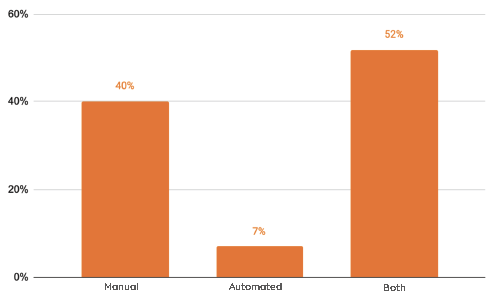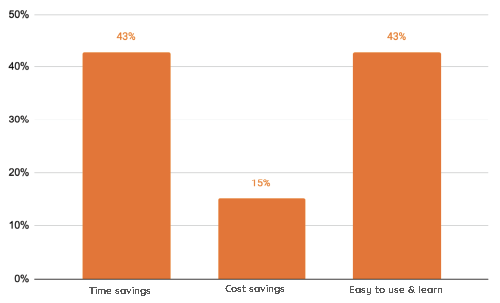Introduction
Test and business process automation (RPA) is a trend with strong growth in organizations and selecting an appropriate tool is a challenge for any company.
Find out what more than 200 professionals responsible for technology and innovation areas and those who actively participate in QA tasks in several Latin American companies answered in this survey conducted by Software Testing Bureau.
The trend of test automation and business process automation (RPA) in Latin America
Like any trend, many companies have joined without having an adequate process for the selection of a tool that fits the reality and possibilities of their business and allows them to achieve their goals.
To find out what are the most valued aspects of an automation tool, we recently conducted a survey.
One of the questions was about the type of software testing they perform and this was the result:

Thus, the answers show that most of the organizations already perform automated tests. However, there is still a high percentage of companies that maintain the traditional practices of manual testing.
Our vast experience in the software quality industry, allows us to ensure that the ideal and most appropriate is to maintain a balance, where undoubtedly, automation occupies an increasingly prominent role for those test cases where the validation of business-critical functionality and integration to DevOps methodologies are being implemented or in the near implementation plans.
It is important to choose right
Based on the data obtained, we believe that although test and business process automation (RPA) is a trend that is growing exponentially in companies in Latin America, a poorly chosen or poorly implemented tool will jeopardize the initiative and cause adverse results for the business.
Most important characteristics of automation tools
Another question we asked was about the features they consider most important and these were the results:

When analyzing the results, it is striking that cost is not the most relevant variable. It is much more valued that the tool is easy to use and learn, and that the time savings are important, both in execution and in the process of designing and creating the automation.
It is precisely in these two aspects where we have found that in Latin America a significant percentage of companies that have experimented with automation had to go through rough terrain.
The main barriers to automation
Based on the survey, the barriers mentioned by companies when automating are:
- Cumbersome implementation. They have found the implementation of projects of this nature very cumbersome.
- Human resources. Human resources are not ideal for robot programming.
- Knowledge. Learning to use code-based tools is extremely complex and demanding for the teams.
- Maintenance. Maintenance of code-based automations is complex and drains resources.
Paradigm shift
Therefore, based on these results, it is vital to change the paradigm and select a tool that offers an adequate user experience, that is easy to learn and that the time to create digital robots to automate is reduced and results are generated quickly.
STELA is the tool that has allowed time savings of over 65% in execution and over 80% in the construction of robots.
Why consider STELA
No barriers
STELA adopted the No Code or Zero Code technology, which translates into low barriers to adoption.
Implementation
The implementation of robots is not cumbersome as the user experience it provides is simple, allowing people of any profile to create digital robots to automate software testing and business processes in a few minutes.
Human resources
Being a tool that does not require programming knowledge, it enables non-technical human resources to be used to create digital robots.
Knowledge
STELA training is online, available 24/7, and free at our Academy. Being a codeless or zero-code tool, the training does not require many hours, so anyone can get the knowledge to build digital robots and automate software testing and business processes (RPA).
Robot Maintenance
Several aspects of STELA facilitate the maintenance of the created digital robots.
- STELA Inspector facilitates the process of element identification.
- Workbenches, Labels, Comments and the Spreadsheet View allow you to better document your processes. Following best practice guidelines allows you to create easily maintainable robots.
- Traceability allows you to diagnose and troubleshoot.
Reuse of automations
STELA allows the reuse of bots created in other robots and their maintenance is solved in a simple way. It has the ability to handle different scenarios, and the use of artificial intelligence allows it to recognize changes in applications, creating resilient robots that automatically adapt and continue to function even when the application undergoes changes.
High Return on Investment
STELA is the tool with the best ROI, since it allows not only the automation of software testing, but also the automation of business processes (RPA), at a reasonable cost and tailored to the companies in the region.
See how simple it is to automate with STELA
Interested in learning more or having a meeting? Fill out the form below and we will contact you.